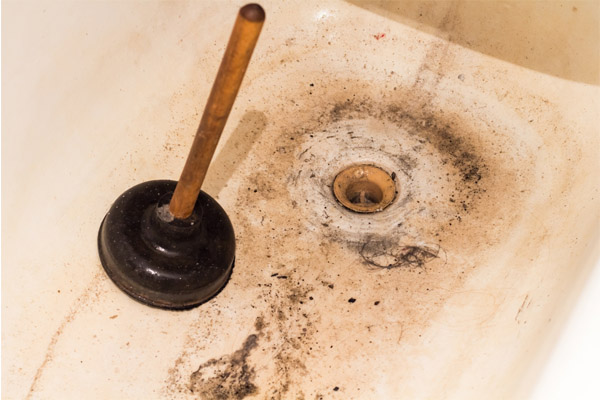Top Reasons Behind Waste Backflow in the Bathtub
Top Reasons Behind Waste Backflow in the Bathtub
Blog Article
Right here further down you'll find additional reliable material around Water Coming up Bathtub Drain.

Sewage back-up in the tub can be a stressful and unsanitary issue for any type of homeowner. Not only is it bothersome, yet it also poses major health threats and shows underlying issues with the plumbing system. Comprehending why sewer is turning up with the bathtub is essential for taking ideal action to deal with the problem effectively.
Intro to the Issue
Understanding the Trouble
When sewer draws back up into the bath tub, it's a clear sign of an issue with the drainage system. The wastewater that needs to be streaming away from your home is rather discovering its back right into your home, which can result in substantial damages and carcinogen.
Possible Causes
Several factors can contribute to sewage back-up in the bathtub. From blockages in the sewage system line to concerns with the plumbing infrastructure, recognizing the source is necessary for locating a solution.
Usual Factors for Sewage Backup
Clogs in the Sewer Line
One of one of the most typical sources of sewage backup is a clog in the sewage system line. This can occur as a result of the build-up of particles, grease, or international things in the pipelines, stopping correct flow and creating sewer to support into your tub.
Tree Origin Intrusion
Tree roots seeking moisture and nutrients can penetrate sewage system lines via tiny cracks or joints. With time, these origins can expand and broaden, creating substantial damages to the pipelines and leading to sewage backup issues.
Aging Infrastructure
Older homes may have outdated plumbing systems that are more susceptible to corrosion, splits, and damage. As pipelines age, they become more prone to leakages and obstructions, boosting the probability of sewer backup events.
Heavy Rainfall or Flooding
Throughout periods of heavy rainfall or flooding, the drain system may become overwhelmed with excess water, creating back-ups and overflows. This can lead to sewer backing up into bathtubs and various other fixtures inside the home.
Wellness Threats Connected With Sewage Back-up
Contamination of Water
Sewer back-up can infect the supply of water in your home, posturing a significant health and wellness threat to you and your family. Exposure to contaminated water can lead to intestinal issues, skin infections, and other diseases.
Spread of Disease
Sewer has hazardous microorganisms, viruses, and bloodsuckers that can cause a series of diseases, including hepatitis, cholera, and gastroenteritis. Entering contact with sewer or infected surfaces puts you in danger of infection.
Mold and mildew Growth
Moisture from sewage backup can produce ideal conditions for mold development in your house. Mold and mildew spores can intensify respiratory issues and cause allergies in sensitive individuals, making timely cleaning vital.
Indications of Sewer Back-up
Foul Odors
Unpleasant odors originating from drains or fixtures, particularly in the restroom, might show sewage backup concerns. These odors are typically strong and relentless, signifying an issue that requires instant interest.
Slow Draining Fixtures
Tubs, sinks, and toilets that drain pipes gradually or not in all could be experiencing sewage back-up. If several fixtures are influenced concurrently, it's likely that the problem stems from a common point, such as the major sewer line.
Gurgling Noises
Unusual gurgling or bubbling sounds originating from drains pipes when water is running elsewhere in your home are a measure of air caught in the plumbing system. This air buildup can result from sewer back-up and ought to be investigated immediately.
Immediate Actions to Take
Turning Off Water
In the event of sewage backup, it's vital to turn off the water to prevent more contamination and damages. Situate the primary water shutoff valve in your home and closed it off till the problem can be settled.
Getting In Touch With an Expert Plumber
Dealing with sewer back-up is not a DIY job. Call a qualified plumber with experience in taking care of sewage-related concerns to evaluate the circumstance and perform needed repair work or cleanups.
Staying Clear Of Contact with Infected Water
Up until the sewer back-up is solved, prevent contact with infected water to stop the spread of microorganisms and virus. Use protective gear if you must remain in the damaged location and clean your hands thoroughly afterward.
Preventive Measures
Routine Maintenance of Sewer Lines
Arrange regular assessments and maintenance of your sewer lines to identify and resolve possible problems prior to they rise into major troubles. This can consist of clearing out debris, evaluating for tree root breach, and fixing any kind of broken pipelines.
Mounting Bayou Valves
Consider installing backwater valves in your plumbing system to avoid sewer from flowing back into your home during periods of heavy rainfall or flooding. These shutoffs immediately close when water draws back up, protecting your residential property from contamination.
Correct Disposal of Home Waste
Avoid purging anything other than bathroom tissue and human waste down the commode to avoid obstructions and obstructions in the sewage system line. Dispose of grease, oil, and various other household chemicals appropriately to lessen the threat of plumbing troubles.
Tidying up After Sewage Back-up
Sanitation Procedures
Extensively disinfect and disinfect impacted locations after sewer backup to get rid of damaging germs and avoid mold and mildew growth. Usage appropriate cleaning products and protective equipment to make sure secure and reliable cleanup.
Repair of Affected Areas
Fix any type of damage to floor covering, wall surfaces, or fixtures brought on by sewer backup. Depending upon the degree of the damages, you might need to change carpets, drywall, or various other materials to recover your home to its pre-loss condition.
Why Is Water Backing Up in My Bathtub When I Flush My Toilet?
What to do about a sewer line clog
First, don’t bother with plunging. No amount of plunging will dislodge the clog in a sewer line. The clog is too far away. Plungers are for clogs in the toilet itself, not the sewer line. Plus, the most likely causes of a sewer clog are:
Tree roots Flushed toys or feminine products Grease buildup Those items don’t move easily. And in the case of tree roots, the roots need to be cut out of the pipe and the pipe will need to be repaired.
You’ll need a closet auger. A closet auger is a type of plumber’s snake with a protective cover to keep from scratching the delicate porcelain toilet. If the clog is further down, you may need to remove the toilet or use one of your cleanouts to get to the clog.
We also recommend doing a video inspection of the drain to ensure that the cause of the clog has been completely removed. Otherwise, you could have the same problem again in a few days or weeks.
https://mspplumbingheatingair.com/blog/why-is-water-backing-up-in-my-bathtub-when-i-flush-my-toilet

I have been very interested in What To Do If Sewage Starts Backing Up Into the Shower and I'm hoping you enjoyed my post. Enjoyed reading our review? Please quickly share it. Help another person discover it. I recognize the value of reading our article about Why sewage is coming up through your bathtub.
Schedule An Appointment
Report this page